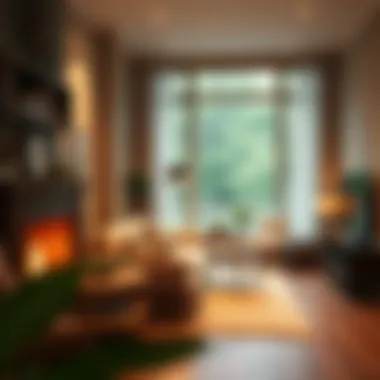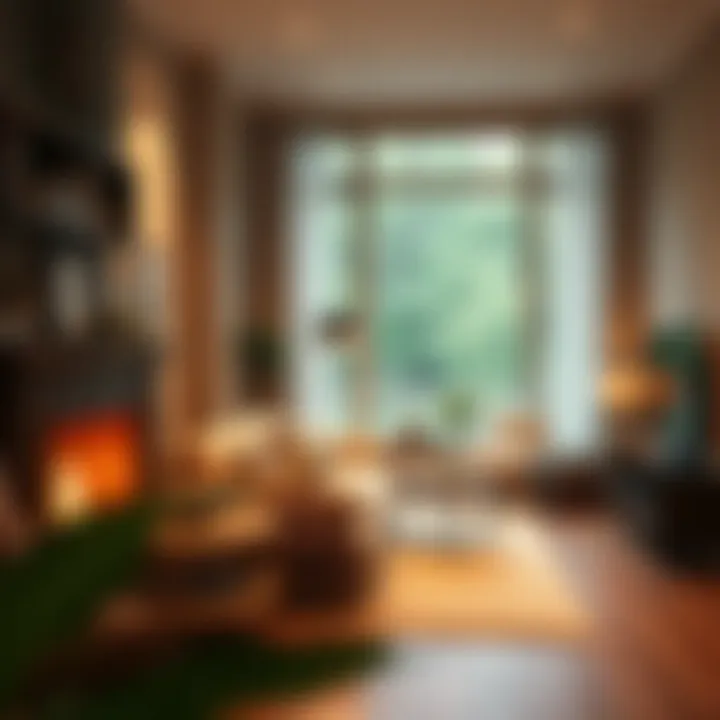Elevate Your Space: Guide to Room Design


Intro
Creating a striking room is not just about filling a space with furniture and decor; it’s an art. When you endeavor to design your home, you're crafting a narrative that reflects not only your tastes but also your lifestyle. Each element plays a crucial role in the overall aesthetics and functionality of the room, so it's paramount to consider every detail, right down to the choice of colors and arrangement of furniture.
You might be wondering where to start in this intricate journey of transformation. Fear not! This guide is tailored to lead homeowners, interior design enthusiasts, party hosts, and gardening aficionados through practical steps to uplift your living space.
The essence of an impressive room resides in a harmonious blend of your personal style with efficient design principles. In this exploration, you will find strategies that range from selecting the right hues to effective furniture placement, culminating in the joyful addition of personal touches that make a house feel like home.
So, let’s dive right into the world of design inspirations.
Understanding Your Space
In the realm of interior design, the phrase "your space tells a story" is more than just a catchy saying. It’s a fundamental step to creating a space that not only reflects personal style but also meets practical needs. Understanding your space is the cornerstone of effective room enhancement and can set the stage for everything that follows. By grasping specific elements like natural light, room dimensions, and current decor, you can make informed decisions and sidestep common pitfalls in design.
When you take the time to truly assess your space, you’re not just observing the physical attributes; you're evaluating how it functions in your daily life. This understanding provides clarity on what works and what doesn’t, allowing you to design an environment that compliments and enhances your lifestyle.
Assessing Natural Light
Natural light is often overlooked, yet it has a profound impact on the mood and perception of a room. Think about how sunlight streams through a window or is filtered by curtains. Good lighting can transform even the dullest of rooms into vibrant spaces.
To assess natural light, consider the following:
- Time of day: Observe how light changes throughout the day. Is there a room that feels cold in the morning sun but warm when the sun sets?
- Orientation of windows: South-facing windows usually catch more sunlight throughout the day compared to north-facing ones.
- Surroundings: Tall buildings or large trees can block sunlight. Understanding these external factors is vital.
By noting these elements, you can make adjustments like choosing lighter paint colors or adding mirrors to reflect light, creating a bright and airy feeling.
Identifying Room Dimensions
Room dimensions serve as the blueprint for your design journey. Knowing the exact measurements helps you realize the potential (or limitations) of your space. A room may appear spacious but can easily become cramped with oversized furniture or inappropriate arrangements.
Here are steps to effectively identify room dimensions:
- Measure accurately: Use a tape measure to note the length and width of the room, along with the height of the walls.
- Sketch a floor plan: A simple sketch can help visualize how furniture might fit. A floor plan allows you to play with arrangements on paper without the hassle of heavy lifting.
- Consider architectural features: Windows, doors, and built-in shelves can influence furniture placement and overall design. Don’t forget to account for these in your plans.
Knowing your room dimensions not only aids in furniture selection but also helps in visualizing the flow of space.
Analyzing Current Decor
Before diving headfirst into new design trends, stopping to analyze your current decor is essential. Often, renovation is about refining what already exists, rather than starting from scratch.
To analyze your current decor:
- Audit personal style: What elements do you love? Is there a color palette that resonates? Understanding what you have helps in identifying what you lack.
- Evaluate furniture and accessories: Assess the condition and style of your furniture. Does it complement the space, or does it clash? This step can prevent unnecessary expenditure on new items that may not fit the existing theme.
- Decide on a ‘sense of place’: Certain items might evoke memories or have sentimental value. Consider the role they play in your design, as they can be focal points or backgrounds that support a greater narrative.
By thoughtfully analyzing your current decor, you gain insight on how to enhance the aesthetic and functionality of your room without losing the essence of your personal taste.
Understanding these aspects of your space paves the way for a smoother design process, allowing creativity to flourish within the parameters of practicality. With a clear understanding of natural light, room dimensions, and current decor, you’re winding down the road to a well-designed environment that fits your lifestyle.
Establishing a Design Concept
Establishing a design concept is a cornerstone in transforming a space from ordinary to extraordinary. It provides a framework to ensure every choice made in a room – be it color, furniture, or decorative elements – resonates with a cohesive vision. A strong design concept not only expresses personal style but also considers the room's functionality. It acts like the blueprint of a building; without it, the end result can be disjointed, lacking harmony and purpose.
When defining your design concept, you need to think about how the different elements will work together. The beauty of establishing a solid concept lies in the clarity it brings to the decision-making process. Think of it as creating an instruction manual for your space. Knowing whether you're leaning towards a vibrant bohemian vibe or a serene minimalist approach will guide you in choosing the right shades, materials, and even fixtures.
"A great design concept embodies both style and substance. It’s about creating a space that reflects who you are while serving a purpose that fits your lifestyle."
In the subsequent sections, we delve into the nuances of defining your aesthetic and the subtleties of incorporating themes, which play crucial roles in establishing this concept.
Defining Your Aesthetic
Defining your aesthetic is the first step in establishing a design concept. It’s where your personality spills into your home’s walls. Take a moment to think about what you love. Do you gravitate towards bright and bold colors, or does soft pastels sing to your soul? Ask yourself questions like:
- What colors make me feel happy or calm?
- Are there textures I prefer, such as smooth or rough?
- Which patterns do I enjoy, geometric or organic?
Getting clear on these aspects allows one to tailor a design aesthetic that feels distinctly you. Perhaps you love the warmth of rustic wooden furniture, or you’re drawn to sleek modern lines. Recognizing these preferences creates a foundation which everything else can build upon.
Incorporating Themes
Themes add layers and depth to a design concept, offering a guiding principle that enhances the overall aesthetic. Let’s explore three popular themes that can be incorporated into room design:
Minimalist
Minimalism is all about stripping away the unnecessary and focusing on the essentials. It relies on a neutral color palette, clean lines, and simple forms. The key characteristic of this style is its emphasis on functionality. By embracing minimalism, you create a tranquil and uncluttered environment, which can be quite refreshing in a world often filled with excess. However, some may find it a bit cold or stark if not balanced with the right textures or personal touches. The unique feature of minimalism lies in its ability to foster peace and clarity, granting a sense of spaciousness that many desire in their homes.
Industrial
Industrial design speaks to the raw, unrefined beauty of spaces that may have originally been factories or warehouses. The hallmark of this style is the use of exposed metal, brick, and wood juxtaposed with modern furnishings. This theme can be appealing for its edgy, urban aesthetic, often creating a sense of character and history. One might love the cool sophistication of sleek metal light fixtures against rugged concrete walls. However, balancing these materials is essential; too much rawness can easily tip into a space that feels more like a construction site than a cozy home.
Bohemian
The bohemian theme is a vibrant celebration of eclectic patterns, rich colors, and a mix of cultural elements. It encourages personal expression, blending various decor styles without the need for strict rules. The key characteristic here is freedom, allowing you to incorporate an array of items from different eras and places, creating a unique narrative in your space. However, it’s important to note that without some coherence, a bohemian style can easily tip into chaos. Care must be taken to maintain a balance between the diverse components, ensuring the room feels welcoming rather than cluttered.
By incorporating any of these themes, or a combination thereof, you can create a lively and impactful design concept reflective of your individuality while keeping functionality at the forefront. The integration of these elements not only enhances aesthetics but also amplifies the purpose of each room within your home.
Color Schemes and Palettes
Color schemes and palettes are not just about picking pretty colors; they create the foundation of any room's aesthetic. A well-thought-out palette influences how a space feels and affects moods and perceptions. With the right combination of colors, you can transform a monotonous room into a vibrant sanctuary or a chaotic space into a tranquil haven. When planning a room redesign, it’s essential to consider how the colors you choose will harmonize with each other and the existing elements of the room.


Choosing a Base Color
The base color serves as the primary hue for your room. It’s usually a neutral tone—think soft grays, warm beiges, or classic whites—that forms the backdrop for everything else in the space. When choosing a base color, it's vital to consider the natural lighting and the room's function. For example, a cool blue can evoke calmness, making it perfect for bedrooms, while a softer beige can create an inviting atmosphere in living spaces. Here are some factors to consider:
- Lighting: How much natural light does your room receive? Darker colors can make a small room feel even smaller if it lacks sufficient light.
- Functionality: Consider the purpose of the room. A professional workspace might benefit from calmer tones to foster focus, while a vibrant kitchen can thrive on warmer shades like yellow or orange.
Using Accent Colors
Accent colors inject personality into your room, providing crucial visual contrast and interest. They literally pop against the base color, drawing the eye and emphasizing particular areas. Whether through decorative pillows, wall art, or even a bold piece of furniture, these colors can express your style. The key here is moderation; too many accent colors can overwhelm the viewer.
Some effective strategies for incorporating accent colors include:
- Complementary Colors: Look at the color wheel; colors opposite each other can create stunning contrasts.
- Monochromatic Schemes: Utilize variations of a single color in different shades to maintain a cohesive and sophisticated look.
- Seasonal Variations: Changing accents with the seasons can keep your space fresh. Bright colors in summer can shift to deeper tones in fall.
Color Psychology in Design
Color psychology dives deep into the impact colors have on human behavior and emotions. For instance, certain hues can induce feelings of happiness, serene, or even anxiety.
- Blue promotes calmness and serenity, making it suitable for bedrooms and bathrooms.
- Yellow, on the other hand, can invoke feelings of joy and energy, ideal for kitchens or play areas.
- Green is often associated with nature and can bring a refreshing, restorative feel into any space.
"Color is a power which directly influences the soul." – Wassily Kandinsky
Understanding these psychological effects helps homeowners create spaces that not only look good but feel good. When designing your room, consider the emotions you wish to evoke and select your colors accordingly.
By thoughtfully considering these aspects of color schemes and palettes, you’ll set the stage for a room that resonates with your style and enhances your living experience while simultaneously keeping practicality at the forefront. The journey of color is less about mere preference and more about creating a harmonious environment that elevates your everyday life.
Furniture Selection and Arrangement
When it comes to revamping your living space, the selection and arrangement of furniture plays a crucial role. It’s about more than just filling a room with items; it’s about creating an environment that promotes comfort, flow, and functionality. A well-thought-out layout can transform even the most mundane areas into welcoming havens.
Choosing Functional Pieces
Selecting furniture that meets the demands of your daily life should be your first port of call. Don’t just chase trends; rather, focus on durability and usability. A sturdy, multifunctional coffee table can act as both your magazine perch and an impromptu dining space. Likewise, a sofa bed can cater to guests without sacrificing your aesthetic.
In busy homes, look for items that are easy to maintain. For example, opting for a material like microfiber means spills are less of a disaster. When considering size, it’s essential to keep scale in mind; large furniture can overwhelm a small room and vice versa. Each piece you select should serve a purpose — ideally multiple purposes, blending style with practicality.
Space Optimization Techniques
Maximizing space doesn’t just refer to keeping clutter at bay; it’s about astutely arranging your furniture in ways that make your home appear and feel larger. Here are a few pointers:
- Go vertical: Utilize tall bookshelves or wall-mounted storage units to draw the eye up and free up floor space.
- Choose furniture with legs: Options such as sofas and chairs raised on legs can create an illusion of more space.
- Create zones: Use rugs or furniture arrangements to delineate areas within a room. This strategy not only organizes the space but also gives a sense of purpose to different sections.
- Opt for transparent materials: Glass tables or acrylic chairs can visually lighten a room while still providing function.
Creating Conversation Areas
One of the joys of a well-arranged room is its potential to foster interaction. Thoughtful arrangement can encourage conversation and connection, making your space more inviting. Here are strategies to craft engaging conversation areas:
- Face the seating: Ensure that chairs and sofas are positioned toward each other, rather than against walls or at odd angles. This encourages dialogue.
- Consider traffic flow: Leave enough space between furniture for easy movement. A good rule is to allow at least two to three feet of space in pathways.
- Add a central piece: A coffee table can anchor the space, where conversations happen and refreshments can reside. A unique decorative item on it can serve as a conversation starter.
In summary, focusing on furniture selection and arrangement is not merely about aesthetic appeal; it’s about creating functional, inviting spaces that reflect your personal style and meet your day-to-day needs. Investing time and thought into this aspect of design can lead to a space that resonates well with those who enter.
Lighting Considerations
Lighting plays a pivotal role in the overall ambiance of a room. It can elevate a space from basic to extraordinary, highlighting features and creating a mood that can range from cozily intimate to brightly energized. When designing an impressive room, considering how light interacts with your space is crucial. Not only does adequate lighting enhance functionality, but it also impacts our emotions and perceptions of the space.
Effective lighting solutions make a room feel more inviting and spacious, while poor lighting can lead to feelings of claustrophobia or gloom. Therefore, understanding the types of lighting available and how to implement them will greatly benefit your design endeavor.
"Good lighting is a crucial part of the design. It influences our mind and feelings, supporting the function of the space, and is one of the easier ways to transform a room’s character."
Layering Light Sources
To create a well-lit room, it's wise to layer different types of lighting. Layering typically consists of ambient, task, and accent lighting. Each type serves its own purpose and contributes to the overall feel of the space.
- Ambient Lighting: This is the general illumination, the base layer. Think of it as the soft glow that fills the room. It can come from various sources like ceiling fixtures, recessed lighting, or even natural light filtering through windows. It sets the stage for other lights and provides a comfortable brightness.
- Task Lighting: Aiming at helping with specific activities, task lighting includes table lamps for reading or under-cabinet lights in kitchens. This lighting helps ensure that activities like cooking or studying can be done safely and without straining one's eyes.
- Accent Lighting: This adds drama and emphasizes particular features or artworks in the room. Spotlights or wall-mounted fixtures can highlight a beautiful painting or an interesting architectural detail.
Incorporating a mix of these layers is essential for achieving a balanced and functional lighting scheme. It allows flexibility, letting you adjust the mood simply by changing the types or intensity of the light.
Incorporating Natural Light
Natural light is perhaps one of the most treasured elements in room design. It brings warmth and a sense of openness that artificial lights struggle to replicate. Making the most of natural light can be done through several thoughtful techniques:
- Window Placement: Choose window sizes that align with your design goals. Larger windows can dramatically increase the amount of daylight coming in. If possible, consider the direction your windows face—south-facing windows grab sunlight throughout the day.
- Reflective Surfaces: Mirrors and light-colored walls can enhance the light flowing into a room. Strategically placing mirrors can bounce light around the space, making it feel larger.
- Open Layouts: If renovation is on the table, think about open floor plans that minimize obstructions to light flow. Open spaces allow sunlight to travel deeper into the house.
Taking advantage of what nature provides can dramatically affect how a room feels. This light doesn’t just brighten a space but also contributes to energy savings and a healthier lived experience.
Choosing Fixtures that Fit Your Style
Selecting the right light fixtures isn’t just about their practical function; it’s also about how they reflect your individual taste. Your fixtures can showcase your style while enhancing the lighting experience.
- Modern Styles: Sleek lines and minimalistic designs define contemporary fixtures. Metals like brass and chrome often feature prominently in this aesthetic.
- Rustic Touches: If you prefer the country charm, think about using fixtures made from wood or wrought iron. These can maintain a warm, homey feel.
- Artistic Expressions: Pendant lights and chandeliers can act as focal points in a space. Opt for unique designs that tell a story or evoke certain emotions.
When choosing fixtures, consider both form and function. A beautiful light fixture should not only look good but also provide ample light, seamlessly integrating into your room's overall design.
Textiles and Materials
Textiles and materials play a pivotal role in room design, influencing both the aesthetic quality and the comfort of a space. It's not just about choosing pretty fabrics; the right textiles and materials can transform a room into a sanctuary. They introduce warmth, depth, and a sense of completion. Think of them as the subtle brushstrokes that elevate an ordinary canvas into a masterpiece.
When selecting textiles, consider their functionality as well as their visual appeal. Different fabrics serve various purposes: heavy drapes create a cozy atmosphere, while lightweight ones can invite airy freshness. The materials you choose reflect your personality and lifestyle, making thoughtful selections essential in achieving a harmonious environment.
Moreover, textiles add layers to a room, making it feel more inviting and complete. Fabrics like cotton and linen lend a casual vibe, while silk or velvet can communicate luxury. Understanding how to balance these elements can make all the difference in crafting a space that feels both stylish and genuinely comfortable.


Selecting Fabrics for Comfort and Style
Choosing the right fabrics is a bit like picking the perfect outfit for a date; you want to look good but also feel comfortable. Different materials can significantly impact how a room feels, so pay attention to aspects such as texture and durability.
- Natural fibers: Fabrics like cotton, wool, and linen provide breathability and warmth, making them a brilliant choice for upholstery or curtains. They're great at regulating temperature, which can keep the atmosphere cozy year-round.
- Synthetic materials: Polyester and nylon are excellent for durability, especially if you have kids or pets. They can endure spills and wear, keeping your space looking sharp.
- Blended fabrics: These often combine the best of both worlds, offering both comfort and resilience. For example, a cotton-polyester blend can be soft yet sturdy.
When considering style, patterns and colors become essential. Bold prints might add excitement, while soft neutrals can help create a calm ambience. Ultimately, the fabrics should align not only with the room's design concept but also cater to daily use.
Implementing Variety in Textures
A room that relies solely on flat surfaces or uniform materials might feel uninspired. Mixing textures can indeed breathe life and interest into your space. Texture can come from various sources, including fabrics for furnishings, decorative accessories, and surfaces, whether smooth, rough, shiny, or matte.
The key benefits of incorporating different textures include:
- Visual interest: A mixture of textures such as plush cushions, knotted throws, and sleek furniture creates a dynamic environment that catches the eye.
- Layering: Adding layers of different materials, from soft rugs to metal or wooden accents, can create dimensions and depth in the design. This layering tactic can elevate a simple space into something striking.
- Comfort: Soft textures promote relaxation. Imagine sinking into a corded armchair while being surrounded by soft cotton or fluffy wool. The comfort factor shouldn’t be overlooked when designing your perfect haven.
To implement texture variety effectively:
- Begin with a foundational piece, like a textured area rug. Add layering options on top, such as a knit blanket or leather poufs for contrast.
- Use cushions of varying textures on your sofa—think of adding a velvet cushion with a linen one next to a chunky knitted throw for visual richness.
- Don’t forget about wall textures, too! Think about how painted walls, stone or brick accents, and textile wall hangings can play together to provide a cohesive yet diverse look.
"Texture is the silent element that adds depth and warmth to your design."
Art and Decorative Elements
Art and decorative elements can truly breathe life into any given space. They serve as the icing on the cake, transforming a mere living area into a sanctuary reflecting your personality and tastes. These elements not only enhance the aesthetic appeal, but also provide a sense of comfort and warmth that turns a house into a home.
Incorporating art into your decor can add depth, provoke thought, and initiate conversation. Whether it's a striking painting that grabs attention or a photograph that recalls fond memories, the right pieces can create emotional connections and elevate your space beyond the mundane. Decorative elements like vases, sculptures, and textiles further contribute to this ambiance, helping you achieve a cohesive look that speaks volumes about your style.
Curating Artwork for Personal Expression
Choosing artwork is more than simply picking pretty pictures; it’s a chance to express yourself. The artwork you choose should resonate with you personally and represent who you are. Start by thinking about the feelings you want to evoke in your space.
- Start with Your Preferences: Try to identify the styles you enjoy, be it abstract, realism, or modern art. You may find it helpful to look through online galleries or visit local exhibitions.
- Consider Size and Scale: A large canvas can be a focal point, while smaller pieces work better in groupings. Remember, the scale of your artwork should be in harmony with the space.
- Themes and Colors: Choose pieces that complement your existing color schemes. This doesn’t mean everything needs to match exactly, but finding a link through colors or themes can create a unified aesthetic.
Ultimately, the best art is the one that resonates with your soul, and the more personal it is, the more impactful it will feel in your room.
Incorporating Plants and Natural Elements
Adding greenery can uplift both your mood and the overall atmosphere of the room. Plants act as natural air purifiers, breathing life into your space. The incorporation of natural elements creates a balance between the organic and the designed, grounding the overall aesthetic.
- Choose Low-Maintenance Plants: If you don’t have a green thumb, don’t fret. Potted succulents, snake plants, or pothos are forgiving and adaptable to varied lighting conditions.
- Utilize Creative Planters: The pots you select can also be an artistic statement. Whether it’s a vintage terracotta pot or a sleek modern ceramic one, the container contributes significantly to the decor.
- Think About Placement: Position plants strategically on shelves, hanging from the ceiling, or even as a centerpiece on your table to make them integral to the design rather than an afterthought.
As you add greenery, remember it's not just about decor; it's about fostering a living environment that feels rejuvenating and inviting.
Utilizing Shelving and Display Methods
Shelving can serve both functional and aesthetic purposes. If done right, shelves can display your treasures and keep your belongings organized without cluttering the space.
- Open Shelving for Visibility: Using open shelves helps create an airy feel. Arrange books, decorative items, and plants to form layers of interest, leading the eye through the space.
- Box Shelves for Creativity: Consider utilizing box shelves in unique shapes or configurations. This approach adds modern flair and can be a standout design element.
- Consider Lighting: Highlight your display by incorporating lightweight LED strips or small spotlights that can draw attention to specially curated pieces or collections.
Ultimately, effective shelving goes beyond mere storage; it showcases your story and brings an element of design to your room.
By carefully curating artwork, incorporating plants, and utilizing innovative shelving, the decorative elements in your space can sing in harmony with your personal style and needs.
Creating a Cohesive Look
Creating a cohesive look in a room is essential for establishing a sense of harmony and sophistication. It's about weaving together different elements so they don’t just coexist; rather, they enhance each other and create a unified emotional experience. When all aspects of the space—from furniture to colors and accessories—work together, the overall ambiance is elevated. This cohesive design not only pleases the eye but also makes the room more inviting and comfortable.
A cohesive look can reflect your personal taste while also serving practical functionality. For instance, if you aim for a modern vibe, each piece should echo that aesthetic. Think about clean lines, minimal decorations, and a balanced color palette. Alternatively, if eclectic is the name of the game, you might mix various styles, but still need to keep a common thread to prevent chaos. The challenge lies in achieving just the right balance, letting every element shine while ensuring they all tell a coherent story.
Bringing Together Various Elements
When trying to bring together various elements in a room, start by identifying a common theme or color palette that resonates with your vision. Color can be a powerful way to tie different pieces together. Consider using a primary color that appears on larger pieces, such as a sofa or a wall, and then repeat that color in smaller accessories, like cushions or artwork. This strategy creates visual continuity.
Material choices are another avenue to explore. By selecting similar materials or textures—like natural wood finishes, soft fabrics, or metals—you can establish a sense of cohesion even amid diverse styles and shapes. When mixing items, be mindful of proportion, scale, and placement. Ensuring that larger items are not overshadowed by smaller ones is crucial in crafting a balanced appearance.
"Design is thinking made visual." - Saul Bass. This quote emphasizes the concept that every decision, from layout to accessory choice, contributes to the overall narrative of the space.
Avoiding Clutter and Overcrowding
A well-curated room cannot thrive amid chaos. Avoiding clutter and overcrowding is vital for maintaining that cohesive aesthetic. Too many mismatched items or excessive decor can muddle the space's focal points. To combat this, adopt a mindset that prioritizes quality over quantity.
One useful tactic is to revisit your possessions regularly. Assess which items you truly love or find useful, and consider donating or discarding the rest. Another strategy is to use multifunctional furniture that minimizes necessary items in the room. Smart nesting tables or ottomans with storage can keep your space tidy without sacrificing style.
Also, be intentional with accessory placement. Arranging various items into groups can create visual interest while avoiding the scattered feel of disorganization. Remember, each piece should have its purpose and place.
Innovative Storage Solutions
When it comes to designing a room that is both impressive and functional, innovative storage solutions are paramount. Not only do these solutions help in managing clutter, but they also allow for better utilization of the available space. In a world where space can often be limited, clever storage techniques can transform a chaotic area into an organized haven. The key here is to think outside the box and consider options that blend seamlessly with the overall design of your room while providing the functionality you need.
Maximizing Vertical Space
One often-overlooked aspect of room design is vertical space. While we usually focus on what’s on the floor, looking up can reveal a whole new world of possibilities. Shelves are a classic solution, but the way they’re incorporated can be a game changer. Consider installing floating shelves that draw the eye upward, or perhaps a tall bookshelf that doubles as a piece of art. Use crates or boxes that can be stacked to create unique displays that add character while serving as storage.
- Wall-Mounted Organizers: Use wall-mounted racks for everything from books to plants. Not only do they save space but they also bring in an artistic element.
- Hanging Storage: In kitchens or bathrooms, hang pots or baskets to keep utensils handy and off the counters. This tactic not only clears surfaces but also adds to visual interest.
"When storage solutions are both practical and aesthetically pleasing, they enhance the overall feel of a room while simplifying daily routines."


Think beyond traditional shelves. Why not install a pegboard on the wall for tools or craft supplies? It’s practical but also allows for easy customization depending on your needs. Thus, maximizing vertical space isn’t about cramming items up high — it’s more about using the height efficiently to maintain order and accessibility.
Hiding Items for a Clean Look
The appearance of a room can drastically impact how we feel in the space. Ultimately, a clean look often hinges on how well we manage our less-than-aesthetic belongings. Hiding items in plain sight or out of view can keep the room feeling fresh and uncluttered. Here are some effective strategies:
- Storage Ottomans: These serve a dual purpose by providing both seating and hidden storage for blankets, magazines or even children's toys. Perfect for living rooms and bedrooms alike.
- Under-Bed Storage: This is a goldmine, especially in a smaller home. Storage boxes or drawers fit perfectly beneath the bed, turning that often-neglected space into a functional area.
- Hidden Cabinets: Consider furniture that incorporates hidden storage, such as coffee tables with compartments. This elegant solution keeps your items out of sight without compromising on style.
Being strategic about what you store and where you place it can be a pivotal decision in designing a room that feels open and inviting. Aligning storage solutions with your aesthetic will ultimately yield a space that is both visually striking and practical for everyday living.
Embracing innovative storage will not only make life easier but it will also reinforce your design vision, ensuring that every object has its place while still leaving the space feeling light and free.
Personal Touches to Consider
When it comes to designing a room that leaves a lasting impression, it's the personal touches that transform a generic space into a true reflection of one's personality. These distinctive elements serve as the icing on the cake, contributing to both the aesthetic appeal and the comfort level of the space. Incorporating personal artifacts not only elevates the room's atmosphere but also tells a story, creating a conversational backdrop that engages guests and makes anyone feel at home.
In essence, personal touches offer a unique blend of functionality and artistry. They echo your journey, interests, and values, providing deeper meaning beyond mere decoration. Thoughtful curation can foster an emotional connection to your space, ensuring that it not only looks magnificent but also resonates with your life. Below are considerations for how two specific approaches—displaying personal collections and incorporating sentimental objects—can profoundly influence your room's vibe.
Displaying Personal Collections
Displaying personal collections adds a dynamic and personalized element to any room. Instead of relegating cherished items to dusty drawers or cramped cabinets, showcasing them gives them the prominence they deserve. Whether you're into vintage cameras, travel souvenirs, or a compilation of unique pottery, taking time to organize these items visually can speak volumes about you as a host.
- Thoughtful Arrangement: Group like items together or use tiered shelving to create an engaging display. For example, an arranged collection of sea shells can evoke memories of coastal vacations, making your space more inviting.
- Framing Techniques: Consider framing special postcards or prints and weaving them into your collection. This adds depth and can tie various items together thematically.
- Spotlighting Collections: Use strategically placed lighting to highlight these collections, ensuring they catch the eye as soon as someone walks into the room.
Personal collections can be a conversation starter and create a sense of warmth, setting your space apart from a sterile environment.
Incorporating Sentimental Objects
Incorporating sentimental objects into your design is akin to weaving personal narratives into the fabric of your living space. These items yield deeper significance than mere decoration; they often evoke memories and experiences that shape who you are. Here are a few ideas:
- Family Heirlooms: Think about displaying that antique clock passed down through generations. Its presence not only enriches the design but also serves as a reminder of family history.
- Travel Mementos: Have a collection of unique items from places you've visited? Consider crafting a dedicated shelf or wall montage. This not only keeps your memories alive but also invites sharing stories with guests.
- DIY Projects: Make items that speak to your experiences, such as framed photographs or wall art. These bespoke pieces infuse character into your room and can be continually updated as new memories are created.
"It's these quiet things that shape our spaces and gives them life. Each item tells a chapter of our story, a glimpse into the soul of our home."
By focusing on such personal elements, it becomes easier to cultivate an environment that naturally feels inviting and intimate, allowing others to get a taste of your world. A room suffused with personal touches doesn’t just showcase style—it showcases you.
Integrating Technology
Technology has woven itself into the fabric of our daily lives, changing how we interact with our environments. When it comes to interior design, integrating technology means more than just adding gadgets; it’s about enhancing comfort, efficiency, and the overall ambiance of a room. Think of technology as a silent partner in your design journey. It harmonizes the functional aspects of a space while elevating its aesthetic appeal.
By incorporating smart home features and audio/visual enhancements, homeowners can create a living environment that is not only stylish but also intuitive to their needs. This is essential in today’s fast-paced lifestyle, where convenience roams hand in hand with a desire for elegance. When considering the integration of technology into your space, keep in mind the specific elements that resonate with your style and daily habits, ensuring that they enhance rather than complicate your life.
Smart Home Features
Smart home features are the vanguard of modern living. They can range from intelligent lighting systems that adjust based on the time of day, to thermostats that learn your heating preferences over time. The real magic happens when these systems communicate with each other, often referred to as a smart ecosystem.
Benefits of Smart Home Features:
- Convenience: Home automation lets you control your environment with a touch of a button or a simple voice command. Imagine adjusting your room’s lighting or temperature without leaving your seat.
- Energy Efficiency: Smart thermostats and energy monitors help save on utility bills. Not only do they track usage, but they adapt to your habits, ensuring no energy is wasted.
- Enhanced Security: Integrated security systems offer peace of mind. From smart locks to cameras that can be monitored from an app, you have control no matter where you are.
"A smart home is not just about technology; it's about creating a comfortable and efficient living space that makes life easier."
Installation considerations are important too. Assess your current wiring and network capabilities to avoid future headaches. Systems that require high bandwidth may need a solid Wi-Fi connection, so consider a mesh network to keep everything running smoothly.
Audio/Visual Enhancements
When it comes to creating an ambiance that speaks to you, audio and visual enhancements are critical. Modern systems allow for seamless integration of sound and visual elements throughout your living space.
Why Prioritize Audio/Visual Enhancements?
- Cohesive Atmosphere: A well-integrated sound system can fill multiple rooms with music or sounds of nature. Whether hosting a party or enjoying a quiet evening, your space can transform at a whim.
- Home Theater Experience: Imagine settling down to watch a movie in a space that mimics an actual cinema. High-definition projectors, surround sound systems, and smart TVs come together to create an immersive experience.
- Accessibility: Many audio/visual systems now accommodate voice activation and can be controlled via mobile devices. This offers a level of accessibility that is particularly significant for those with mobility issues.
While setting up audio and visual systems, think about acoustics and screen placement. An ideally positioned speaker will not only sound better but can also limit distractions visually. Consider investing in sound panels or acoustic tiles if you're in a particularly echoey space.
Overall, integrating technology in your room isn't just a luxury; it can significantly improve your lifestyle. It's about finding what works for you and your space, ensuring both beauty and functionality go hand in hand.
Maintaining and Updating Your Space
Keeping your living environment looking sharp and feeling welcoming isn’t just about initial design; it’s about what comes after. The process of maintaining and updating your space can make all the difference. Regular attention helps to preserve your home’s aesthetic appeal and functionality, ensuring that it not only looks good but works well too.
One of the core benefits of routine maintenance and updates is the opportunity to adapt your space to changing needs. For example, as families grow or lifestyles shift, your room may require adjustments. Maybe a cozy reading nook turns into a play area for kids, or certain colors just don’t resonate with you anymore. Regular maintenance encourages you to evaluate how well your space serves you and inspires creative changes.
Regular Evaluations
Taking the time to regularly evaluate your room doesn’t mean you have to spend hours every week rethinking your entire layout. Simple checks can be quite effective. Look around every few months. Does the room still make sense? Is there an area that feels cramped or cluttered? Moving furniture every now and then or swapping decor items can rekindle that spark you once experienced.
It’s also a good idea to keep tabs on wear and tear. Faded paint, scuffed furniture, or frayed curtains can sap the vibrancy of any space. Addressing smaller issues immediately often prevents them from escalating into more significant problems. Doing so keeps your space looking its best.
Some simple steps for regular evaluations include:
- Assess wall colors and consider a fresh coat of paint.
- Rotate decorative items to keep things fresh.
- Re-evaluate the functionality of furniture arrangements.
Incorporating a checklist for your evaluations can be a handy tool. That way, nothing is overlooked.
Embracing Seasonal Changes
As the seasons shift, so might your inclination toward different colors, textures, and decor. Spring and summer can bring a vibrant, lighter feel, while fall and winter might invite warmth and coziness. Embracing these seasonal changes can breathe new life into your home.
You might decide to switch up your textiles according to the weather. Linen and cotton works wonders in the warmer months, but as it gets colder, heavier materials like wool or velvet can create a snug environment. Changing cushions, throws, and even artwork can reflect the mood of the season.
Don’t hesitate to make your space reflect the world outside. Here are a few tips to embrace seasonal changes:
- Swap out light, airy decor with warmer, heavier items during the colder months.
- Incorporate seasonal plants that are fitting for your room and the time of year.
- Change color palettes in harmony with outdoor hues, which can create a continuity that feels effortless.
In summary, regularly evaluating and updating your space not only allows you to keep it functional and welcoming, but it also gives you the chance to inject new life and personality as seasons change. Keeping a pulse on your environment ensures it continually reflects who you are and meets your needs as they evolve.







